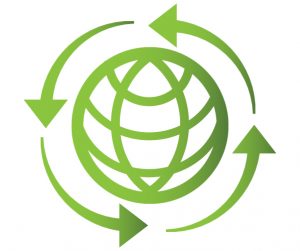While safety and sustainability offices in higher education institutions are often seen as two separate entities with completely separate charges, in reality they are two sides of a single coin. Both groups are charged to protect people, planet, and profits, and the goals of safety are 100% aligned with the goals of a serious campus sustainability strategy. Both offices are often pushing the same outcome, but using different semantics and narratives to do so. When we gain a deeper understanding of the psychologies, semantics, and accompanying narratives of these two disciplines, we can use this insight to the advantage of both groups in communicating with customers and campus stakeholders. In turn, this strengthens both programs and elevates safety and sustainability within our institutional culture; it is a win-win for everyone.
For example, both safety and sustainability offices want campus researchers to shut the chemical fume hood sash in their research labs when they are not in use. Safety professionals might encourage lab users to shut the sash by promoting it as a great engineering control to keep vapors out of one’s breathing zone, and by reminding them that it provides a physical barrier to protect users from splashes and spills. If they want to use more of a regulatory approach, they may even reference the lab safety handbook or state that users must comply with it. For stakeholders motivated by avoiding risk, this is likely to be effective.
Sustainability or Green Labs professionals, on the other hand, might encourage researchers to shut the fume hood sash when it is not in use by explaining that a single fume hood uses up to 3.5 times the energy of an American household in a single year. Or they could explain that shutting the sash (on variable air volume fume hoods) can save up to 40% of the energy used by the fume hood yearly. For campus stakeholders who self-identify as environmentalists, this information will likely motivate them to modify their behavior and shut the sash.

Can I Borrow Your Message?
Both approaches lead to the same desired outcome of shutting the fume hood sash, but they are not equally effective motivators for all stakeholders. Thus, by borrowing from one another’s messaging and approach, both groups can capitalize on how stakeholders self-identify and can give them the opportunity to reinforce their own personal values while engaging in behavior modifications that are both safe and sustainable.
The goal of this co-messaging approach isn’t to change our focus or objectives, but rather to use these insights so we can work smarter, not harder. If your current messaging approach isn’t effective with a stakeholder, borrow messaging from the other group and see if that speaks to the individual’s motivation. At the end of the day, it doesn’t matter how we reach our campus stakeholders, as long as we reach them.
This approach is not limited to research laboratories and can be applied broadly across our campuses. Much in the same manner that one need not be a safety professional in order to consider and prioritize safety, so too one need not be a sustainability professional in order to prioritize sustainability within our institutions. Finally, this use of co-messaging and combining communication strategies is not only effective in meeting individual program goals, but also helps to institutionalize these concepts so they become further imbedded in our campus-wide programming and planning.
Ensuring Safety Requires Effective Communication
The principles discussed above are particularly important if we want to build a culture of safety within laboratories by better incorporating green chemistry. To do this, it is imperative to engage stakeholders outside the lab. While green chemistry and safety initiatives often have the same intent, only 21.5% of environmental health and safety (EH&S) professionals feel they have a successful relationship with their campus sustainability counterparts. Thus, implementation and stakeholder collaboration on green chemistry and other sustainability or Green Labs efforts require deliberate and specific consideration.
In order to successfully incorporate and enmesh safety and sustainability practices into laboratory culture, we must gain a deeper understanding of the psychologies, semantics, and accompanying narratives of these two fields and, ultimately, how these ideas drive the perceptions and attitudes of safety and sustainability professionals. Better understanding these intricacies allows both groups to communicate more effectively and avoid unnecessary pitfalls and confusion. Additionally, this deeper understanding can allow for successful co-messaging of initiatives and give both EH&S and sustainability professionals a larger toolbox from which to work.
Prevention or Promotion: What’s Your Focus?
According to two prominent psychologists, Heidi Grant Halvorson and E. Tori Higgins, people fall into one of two motivational focus categories: prevention-focused or promotion-focused. Motivational focus is a term used by psychologists to describe a personality attribute that predicts performance and informs how we as individuals respond to challenges. Motivational focus influences what we pay attention to, what we value, and what we feel when we succeed or fail. Understanding what category we are in and what category those we interact with are in helps us to better communicate and to be more effective in our interactions. For the purpose of this article and to convey a clearer narrative, we will address the prominent motivational focus of EH&S and sustainability professionals below, although we acknowledge that many individuals experience mixed motivations.
 EH&S professionals fall under the motivational-focus category of prevention-focused. Prevention-focused individuals are motivated by a desire not to lose, and thus, avoiding risk is their primary incentive. They tend to view their goals as responsibilities, typically work slowly and meticulously with high accuracy, and possess excellent problem-solving skills. Their worst-case scenario is to be sliding backward. Prevention-focused individuals are prepared for the worst, stick to tried-and-true methods of doing things, are often uncomfortable with praise or optimism, and feel anxious when things go wrong.
EH&S professionals fall under the motivational-focus category of prevention-focused. Prevention-focused individuals are motivated by a desire not to lose, and thus, avoiding risk is their primary incentive. They tend to view their goals as responsibilities, typically work slowly and meticulously with high accuracy, and possess excellent problem-solving skills. Their worst-case scenario is to be sliding backward. Prevention-focused individuals are prepared for the worst, stick to tried-and-true methods of doing things, are often uncomfortable with praise or optimism, and feel anxious when things go wrong.
These inherent traits give them an advantage as safety professionals, as they are naturally predisposed to be risk averse. EH&S involves a tremendous amount of unseen effort—we rarely hear about our EH&S professionals until something goes wrong. When it comes to safety, no news is good news and usually means your institution’s safety professionals have been hard at work preventing accidents and keeping your institution safe.
The framework of safety is based on regulatory compliance. These initiatives are often mandatory and are designed into standard operating procedures. The repercussions for not following these safety guidelines are often punitive in nature; one might be reprimanded, fined, fired, or incarcerated for a lack of compliance and could even experience injury or death when deviating from safety guidelines. There is great potential to lose when not following safety guidelines, and this is taken seriously by those who are prevention-focused.
The language of safety is also regulatory; it tends to be objective, clear, and strong, and is often perceived as forceful or intimidating. Storytelling is often used as a motivational tool; as such, EH&S professionals, as well as other prevention-focused individuals, tend to respond best to a strong cautionary tale. They are impressed by robust admonitory examples of those whose paths they should not follow, because avoiding risk is their primary motivation.
 When reviewing these same criteria in the field of sustainability, we discover very different findings. This group is promotion-focused; Halverson describes them as being motivated by the concepts of advancement and rewards. They see their goals as creating a path to advancement, and they play to win. They are comfortable taking chances, think quickly and creatively, and work quickly with a higher margin of error. Their worst-case scenario is a failure to advance. Promotion-focused individuals tend to be great brainstormers, are open to new opportunities, are optimists, seek positive feedback and lose steam without it, and feel depressed when things go wrong. The advancement sought by promotion-focused individuals need not be personal in nature; in the case of sustainability initiatives, the advancement sought after is that of a sustainability gain.
When reviewing these same criteria in the field of sustainability, we discover very different findings. This group is promotion-focused; Halverson describes them as being motivated by the concepts of advancement and rewards. They see their goals as creating a path to advancement, and they play to win. They are comfortable taking chances, think quickly and creatively, and work quickly with a higher margin of error. Their worst-case scenario is a failure to advance. Promotion-focused individuals tend to be great brainstormers, are open to new opportunities, are optimists, seek positive feedback and lose steam without it, and feel depressed when things go wrong. The advancement sought by promotion-focused individuals need not be personal in nature; in the case of sustainability initiatives, the advancement sought after is that of a sustainability gain.
The framework of sustainability is opportunistic—a stark contrast to the regulatory framework of safety. These initiatives are usually incentive-based, tend to be optional, and offer a reward for engagement, such as validating one’s self-identity or personal values, saving resources, or receiving positive recognition. For example, engaging in green chemistry practices validates a personal value for an individual who self-identifies as an environmentalist and wants to reduce their environmental impact.
The language of sustainability is also opportunistic and tends to be softer, more subjective, more encouraging, and congratulatory. Sustainability professionals, as well as other promotion-focused individuals, are motivated by narratives of an inspirational role model, such as someone high performing or uniquely effective, as these individuals are seeking to advance by finding novel solutions to environmental challenges.
Collaboration, Co-messaging, and Context
Although these two fields have differing psychologies and methodologies, they are working toward the same goals. EH&S is a general term used to refer to laws, rules, regulations, professions, programs, and workplace efforts whose purpose is to protect the health and safety of employees and the public, as well as the environment, from hazards associated with the workplace. Furthermore, maintaining a safe environment and taking care of your employees sustains your business and protects your profits. Thus, both safety and sustainability professionals are charged as caretakers of people, planet, and profits. As such, both groups can use this insight to their advantage in communicating with stakeholders and implementing shared initiatives. This approach provides a unique opportunity for them to combine efforts for co-messaging and to borrow from each other’s framework and semantics.
For example, when implementing green chemistry initiatives, an EH&S professional is likely to be interfacing with an individual who is promotion-focused. In this case, there is no motivation for that individual in being told about the regulatory and risk-reducing benefits of green chemistry. They are not motivated by regulatory compliance, nor are they inspired by the fact that it is a great administrative control and improves worker and room safety. However, the EH&S professional can still engage their promotion-focused counterpart to meet the same end goal by borrowing from sustainability’s language and framework and focusing on green chemistry aspects that speak to the other’s motivational language.
The individual is likely to be motivated to modify their behavior through the knowledge that green chemistry reduces hazardous waste, reduces the negative impacts of chemicals on human health and the environment, minimizes negative social justice impacts, and is less toxic to organisms. The framing and narrative may change, but the original goal of helping an individual engage green chemistry techniques is still achieved. Similarly, Green Labs professionals can borrow from EH&S narratives to help meet their goals as well.
While understanding motivational focus is a helpful tool for EH&S and sustainability professionals when interacting with one another, it is less effective in communicating with researchers, as they tend to possess a mixed motivational focus, depending on the nature of their research. Thus, when interfacing with researchers to introduce green chemistry and other green labs initiatives, it is imperative to frame recommendations within the context of their research.
Green Labs initiatives must not be implemented to the detriment of research efficacy or efficiency but instead must provide clear and direct benefit to the researcher. For example, engaging in green chemistry can lead to faster times to market and less regulatory hurdles, which directly serves researchers by potentially advancing their research timelines and output. Explaining how these initiatives directly benefit the researcher will garner the support needed in order to create a cultural shift toward both safety and sustainability efforts within the laboratory.
Star Scott is Green Lab program coordinator, Facilities Management Division, at the University of Georgia, Athens, GA; she can be reached at [email protected]. This is her first article for Facilities Manager.
This article was excerpted and adapted from “Approaches to Incorporating Green Chemistry and Safety into Laboratory Culture,” published in the Journal of Chemical Education and written by Natalie J. O’Neil, Star Scott, Rachael Relph, and Ettigounder Ponnusamy.




